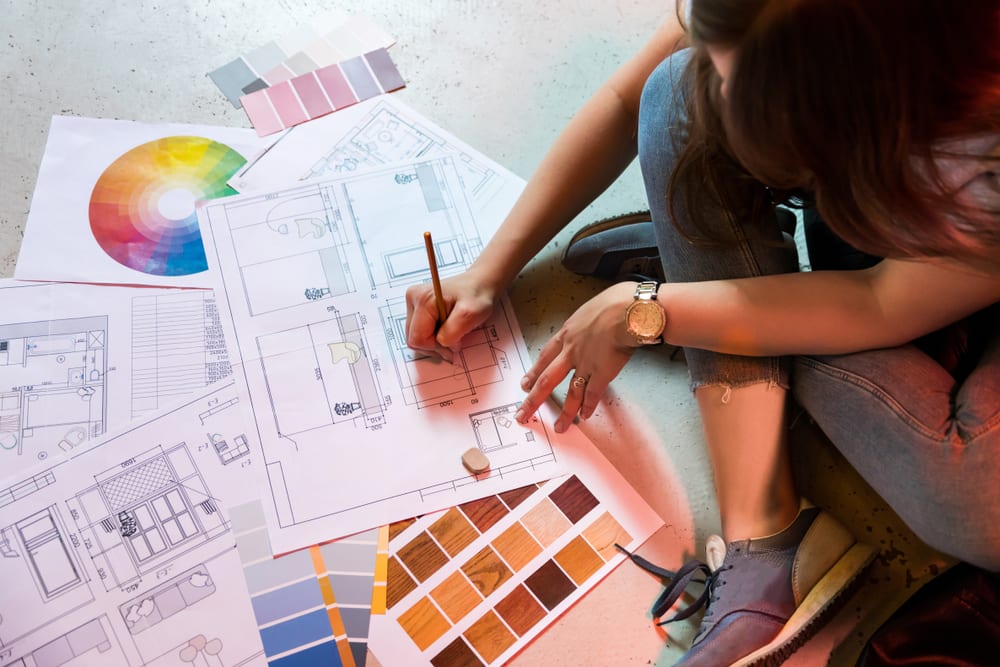What does an interior designer do?
In this guide, you'll learn everything you need to know about interior designers. We'll give you an insight into their daily duties, and the skills and education they need.
 October 6, 2022
October 6, 2022 8 minute reading
8 minute reading
Whether it's a new build or renovation, an interior designer can make every space visually appealing. Everything from the layout of the walls to the colors of the curtains can be the responsibility of these creatives.
There are around 171,000 interior designers in the US. It's a technical role that requires forward thinking and an eye for design trends.
In this guide, you'll learn everything you need to know about interior designers. We'll give you an insight into their daily duties, and the skills and education they need.
You'll learn about the average salary and how this can vary depending on where you live. And, we'll compare similar careers such as interior decorators and architects.
Let's get started.
What is an interior designer?
An interior designer is someone that designs indoor spaces. They combine a range of materials and colors to make sure each room is practical and good-looking. They design both structural and decorative elements, including walls, kitchens, cupboards, lighting, and bathrooms.
Interior designers often have a specialty. For example, they can work exclusively on domestic projects, environmental design, commercial buildings, or office spaces.
Interior designers work closely with clients to understand their unique lifestyles. For example, a family with young children will have different needs than a retired couple.
The process can be complex and the interior designer is involved in every step of the project. They create the initial design, purchase items, and make sure everything is installed correctly.
Interior designers need to provide ongoing updates. It all starts with a brief, so they can decide on a concept. The design has to complement any existing themes either inside or outside of the structure.
Clients may need to be steered in the right direction, especially if their ideas aren't quite right for the space.
Here's an example. An interior designer may be asked to makeover a kitchen and dining area. If the existing home is modern, with crisp whites and neutral grays, a shabby chic kitchen may not be the answer. Interior design themes need to be trendy, yet timeless.
Interior designers also collaborate with builders, plumbers, painters, electricians, and other tradespeople.
They can work for design firms, architects, and renovation companies. Some interior designers are self-employed.
What do you need to be an interior designer?
Most interior designers have a bachelor's degree which equates to four years of study. Some interior designers have a master's degree, which is an additional two years.
There is a range of different study pathways, and students can study in person or online. Some of the topics you can expect to learn about include:
CAD (computer-aided design) and illustration
How to manage space
The design process
Photography
What are the top schools for interior design in the US? The list includes the New York School of Interior Design, Drexel University, Cornell University, and Rhode Island School of Design.
A license may also be required depending on the state. If this is the case, there's the National Council for Interior Design Qualification (NCIDQ) certification exam. Before you can take the exam, you'll need to finish the degree and have at least two years of training and experience in the workplace.

What skills do you need to be an interior designer?
Interior design isn't a career for everyone. There are certain skills that these professionals need to be successful.
What are they? Here are the top skills every interior designer should have.
1. Creativity
Interior designers need to be creative and artistic. No two jobs are the same, and clients have a range of personalities that need to be celebrated.
There are different types of interior design and these can be mixed and matched. For example, office space could feature traditional colors paired with glamorous fittings.
A creative interior designer will know how to put styles together without overwhelming the area. They'll use similar elements from each theme, such as wood types or patterns, to tie everything together.
There can also be challenges where certain items need to be included. A client may have a family heirloom that needs to remain or there could be specific artwork on the walls. They'll embrace these differences and use their creativity to complement every piece.
2. Attention to detail
When it comes to interior design, even the smallest details matter. High attention to detail will ensure that every project is completed to a high standard.
For example, there are thousands of different paint colors. Even a simple white comes with slight variations that can change the look and feel of the room. Any successful interior designer knows that "near enough isn't good enough." So, they take their time to choose the right fittings, fixtures, and materials.
Because interior designer works with others, they make sure everyone is on the same page. They need to give specific instructions and check every detail before completing the job.
3. Computer skills
What else does an interior designer need? Computer skills. First, they rely on software to create 2D and 3D images to show their clients how the design will look. They can experiment with different types of interior design styles, and give the client options.
If they're designing custom furniture or fittings, these can also be showcased using computer programs.
CAD (computer-aided design) software is commonly used in this industry. Interior designers learn how to master this software during university and in the workplace. Some interior designers use creative software such as Adobe Photoshop and Illustrator.
They should also be confident using common programs such as Microsoft Excel, Microsoft Word, and Google Docs.
4. Problem-solving skills
Projects aren't always straightforward. For example, there may be a support beam that can't be removed, or the room could be in an unusual shape. A client could be on a tight budget, or there could be building codes to contend with.
When problems arise, the interior designer needs to find a viable solution. They should be cool and calm under pressure and able to come up with alternatives. Interior designers should feel confident in communicating any changes to both the client and the team of tradespeople.
Here's an example. Let's say the interior designer is planning a bathroom renovation. Their original aesthetic interior design included installing a new bathtub. They then learn this is impossible due to plumbing restraints. They need to quickly come up with alternatives for their client, such as placing it in a different location or having an oversized shower instead.
5. Vision
An interior designer has to visualize the way things will look. They can pick from a range of different interior design styles and everything has to combine seamlessly.
It's not as simple as choosing one color or pattern. For example, painting the walls blue, installing blue cabinetry, and accessorizing with blue floor rugs and cushions will be overwhelming. Instead, they can use the 60, 30, 10 rule.
How does it work? 60% of the room will be made up of the main color. 30% is the secondary color, and 10% is the accent color. The interior designer could use 60% white, 30% black, and 10% red.
An eye for upcycling will also be an advantage. If they plan to remove a wooden beam from the ceiling, can it be repurposed as a dining table? Or, is there an old cupboard that can be rejuvenated and used as a bathroom cabinet?
Some common types of styles in interior design include contemporary, coastal, country, and industrial.
6. Math skills
Next, we have math skills. Choosing the right design interior is important, but making sure everything fits will also be a priority.
There's measuring involved in the design process, and other tradespeople rely on accurate measurements to do their jobs. From a kitchen installer to a carpenter to a glazier, even half an inch can ruin the entire space.
For example, a light fitting that's hung too low can be a head-bumping hazard. A kitchen bench that's too long can block an entrance, or an oven that's too wide won't fit neatly between two cabinets.
Interior designers also need to set budgets. Before the project begins, they'll work with the client on a pricing guide. While this can change with upgrades, the original quote should be as accurate as possible.
7. Communication skills
Interior designers need excellent communication skills. Their clients may not be familiar with the different types of interior design styles, or technical jargon. It can also be a time of anxiety for home and business owners. They may not know what to expect, or how long the process will take.
Interior designer has to get their ideas across and share interior design examples with their clients.
Communication is essential from the first phone call to the final handover. Interior designers can use a range of communication methods including in-person visits, phone calls, emails, and text messages.
Interior designers need to communicate with other professionals. They work with tradespeople and need to schedule work to avoid delays. Plus, they build relationships with suppliers and negotiate better rates.
Interior designer Services by Freelance Experts
How much does an interior designer make?
The salary for an interior designer can vary depending on several factors. For example, location, experience, and employment type can all impact the final salary.
However, in the US the average wage for an interior designer is $29.01 per hour or $60,340 per year. Those in the 10th percentile make around $30,930 per year, while those in the 90th percentile make up to $99,070 per year.
California is the state with the most employed interior designers. Here, the average salary is $70,290 per year.
What state pays the most? If you're in the District of Columbia, interior designers make around $79,420 per year. Following this is Rhode Island, where the average annual wage is $77,250 per year. In Massachusetts, it's $73,140, and in New York, the average salary is $72,220 per year.
The industry also makes a difference. An interior designer working in the architectural or engineering field will have an average annual salary of $71,150. Compare this to someone who's employed in residential building construction, where the salary is $55,000 per year.
An interior designer in specialized design services sits in between, with an average yearly salary of $62,350.
Self-employed interior designers often charge by room so their wages can be much higher. The fee can range between $1,000 and $7,750 per room.
What is the difference between an interior designer and an interior decorator?
An interior designer and an interior decorator aren't quite the same. An interior designer is focused on the whole picture, including the structure, walls, and cabinetry. They make sure the space is practical and visually appealing.
A house interior design styles list may include removing walls, installing showers, and updating kitchen islands.
Decorators deal with furnishings, such as rugs, tables, and curtains. An interior designer often does these same duties on top of their structural elements. On the other hand, interior decorators can't design any structural or fitted components.
What is the difference between an interior designer and an architect?
Architects can work closely with interior designers, but their roles are different.
We know an interior designer focuses on the inside spaces, and these are often individual rooms. They can be asked to help with existing rooms that need a designer touch.
Architects plan new builds and they create blueprints for builders to follow. They can design anything from a small apartment to an entire city.
To become an architect in the US, you'll need to complete a five-year degree. Plus, there's an additional two years of workplace training. Once this is completed, the architect can get certified. Learn more about architectural design services. What services does an interior designer offer?
Interior designers can offer a range of services and can specialize in specific areas.
Here's a rundown of some of the top tasks they can help with.
Kitchen and bathroom design
There's a high demand for kitchen and bathroom renovation. In fact, 35% of homeowners say their kitchen needs an update. Redesigning these spaces can add value to a home and transform an old property into a modern oasis.
Interior designers can be called in to take care of these project types. These days, creating spacious kitchens and bathrooms with modern finishes is on-trend. Butler's pantries, double vanities, and statement splashbacks are just a few additions that may be included.
The interior designer will create a mood board to build ideas for the perfect kitchen and bathroom. Remember, it should tie in with other themes in the home.
Lighting plans
Every building needs lighting. It can create ambiance and change the look and feel of the room. Interior designers know how to select lighting options that match each project. They can work with an electrician to get the positioning just right.
The interior designer can create a lighting plan using CAD software.
Each room will have different lighting choices. For example, in a living room, there may be dimmable downlights that can be turned up or down depending on the purpose. There can be statement lighting above kitchen benches or dining room tables, and heated lamps in bathrooms.
Floor plans
If there's an existing building, it may not be functional. Some older dwellings may not have an ensuite in the main bedroom. And, unlike traditional homes, modern interior design styles usually come with an open floor plan.
Interior designers can look at the space and come up with a new layout. Whether it's a room addition or changing the entire floor plan, these experts can find a workable solution. The goal is to create a design that's suitable for the existing owners and appealing to any future buyers.
Sometimes, a few small changes can make a big difference. For example, moving the kitchen island bench or installing a workspace under a staircase can change the way a room is used.
Custom furniture
Some interior designers specialize in custom furniture. It's all about unique pieces that fit perfectly into the space.
The interior designer may work with upholsters, carpenters, joiners, and artists to create exclusive creations. Or, they may source one-of-a-kind furniture from their contacts.
Custom furniture can fall into any category. For example, an oversized wooden custom bedhead could suit a rustic bedroom. A hand-poured concrete coffee table could fit an industrial living room, or a solid acacia wood dining table could give a home a warm, comfortable vibe.
Interior designers may also source custom wall art, sofas, fireplaces, or TV cabinetry.
Color consultations
Another service interior designers may offer is color consultations. There's usually a flat fee for each session, and clients can discuss different color combinations. The designer will visit them at the site, and look at any existing themes. For example, the color and texture of the flooring and doors can influence paint colors.
Interior designers can help clients understand the interior design style of their home or office, and teach them how to make the right color choices. They can bring a range of color samples and try to match the client's personality to the room.
When clients want to update their own furnishings, cushions, artwork, or throws, they can use the palette they discussed with the interior designer.
Conceptual drawings
Interior designers may create conceptual drawings. This is where their creativity and attention to detail come in.
Conceptual drawings are often the first draft of the room and are drawn by hand. Like fashion designers, interior designers can use pencil and paper to explore different ideas.
They'll include things like color, and space, and highlight any unique features. For example, if there is a window with a view, this will be emphasized in the concept as a space that needs to be in focus. These drawings are usually 3D and once they're complete the interior designer can transfer their sketches to their CAD software.
Furniture layouts
We already know interior designers work on floor layouts, but there are other placements to consider. Where furniture is placed is important because it can add or detract from the room.
For example, a curved sofa facing a fireplace can improve the ambiance in the room. But, a sofa that's too bulky for the space can make the room feel small. Some clients may also have special requests or want furniture that fits with feng shui rules.
Choosing the right furniture and positioning is essential to creating an interior that's welcoming, functional, and spacious.
Setting budgets
Interior designers can help people plan their renovation budgets. They know how much different materials and furnishing cost, and can create an itemized expenses sheet. Programs such as Excel can be useful to keep track of budgets.
If they work for an agency, the interior designer will need to share this information with senior team members.
Because interior designers build networks with suppliers and tradespeople, they can often get better deals for their clients.
The role of the interior designer
In summary, interior designers work on indoor spaces. Most interior designers have a bachelor's degree, training, and certification.
The average salary can vary depending on location, industry, and experience. Some of the top skills every interior designer should have include creativity, attention to detail, and computer skills. Interior designers should also have a vision, problem-solving skills, math skills, and communication skills.
Interior designers can have specialties. For example, some choose to focus on kitchen and bathroom design. They may offer color consultations to show their clients what could work in their space, and they can come up with floor and lighting plans.
Conceptual drawings on paper can help the interior designer get ideas for the project. They can use this process to decide what furniture layouts would work, and whether any custom furniture should be created.
By now, you should know what an interior designer does, and what it takes to become one!


